Summary
Research has shown that high extrusion temperatures result in the most opaque powder coatings. The higher temperatures resulted in better TiO2pigment dispersion, giving rise to increased opacity. This finding was true for both twin- and single-screw extruders.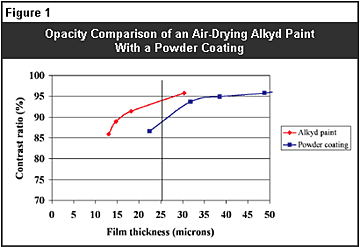
Introduction
Due to an increasing trend toward thinner films1in powder coatings, an investigation has been undertaken at Huntsman Tioxide to optimize the dispersion of TiO2in powder coatings. If dispersion is improved, an improvement in opacity would also be expected. With very thin films, the efficient use of the TiO2is very critical, as thinner films will highlight differences in opacity that would otherwise be masked because of the thickness of the film. Figure 1 shows how much more opacity TiO2gives in an air-drying alkyd paint, compared to a powder coating based on the same TiO2volume concentration. At a dry film thickness of 25 µm, the powder coating gives a contrast ratio of 89%, compared to 94% for the air-drying alkyd paint.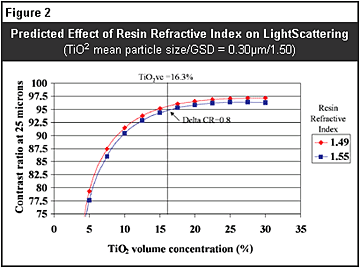
Even though, as Figure 2 shows, the resin refractive index can explain some of the scattering deficiency of the powder coating, there is still plenty of scope to further improve the opacity of these systems2.
In a previous study undertaken by Huntsman Tioxide3, the effect of pigment concentration, maximum powder particle size and film thickness on the optical performance of thin-film powder coatings has been studied. The results of this study showed that optimum film performance is achieved for film thicknesses of 40 to 50µm. The gloss, haze and leveling performance can be further improved by reducing the maximum powder particle size, while the opacity performance remains unaffected.
This study focuses on powder coating extrusion conditions4,5 and how they may affect the opacity of the powder coating.
Methodology
To explore the effect of extrusion conditions on the opacity of powder coatings, it was decided to limit the work to three extruder variables:- Feed rate
- Screw speed
- Operating temperature
The following single- and twin-screw laboratory extruders were included in the work:
- PRISM 16-mm twin screw (25 L/D)
- Buss PCS30-11D single screw (11 L/D)
- Buss PR46 single screw (7 L/D; used in the Huntsman Tioxide laboratories)
An accurate test method for assessing opacity was crucial to the success of the project. Over the years, work has been undertaken within the industry to develop such a test method for powder coatings7,8. The method described below, which was used for this project, is considered to be the most accurate. However, it should be noted that the method is also time-consuming.
Opacity determination of powder coatings-The powder coatings were applied to degreased, 125-µm clear-polyester sheets using a manual Gema Volstatic electrostatic spray unit with the voltage regulated at 90 KV negative.
The polyester sheets were attached to a degreased steel panel of the same size with metal clips. This method of panel assembly reduced the risk of buckling during application and baking. The metal backing panel also reduced static charge within the film and so aided the application of a uniform distribution of powder on to the polyester sheet.
Polyester sheets were coated with varying weights of powder to achieve differing film thicknesses from about 20 to 60µm. The applied films were then placed in an electrically heated circulating air oven and cured for 15 minutes at 180ºC.
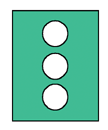
Template for Film-Thickness Measurements
The Yb and Yw values were subsequently measured for the same three circular areas of the powder coatings on a HunterLab ColorQUEST II colorimeter using black and white tiles, respectively.
From the Yb and Yw values the contrast ratios (Yb/Yw x 100) were then calculated. For each powder coating, graphs were plotted of contrast ratio vs. reciprocal film thickness to achieve straight-line plots. From this plot, the contrast ratio was recorded at a film thickness of 25µm, as illustrated in Figure 4.
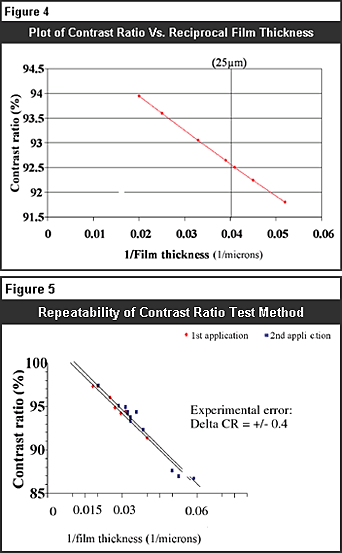
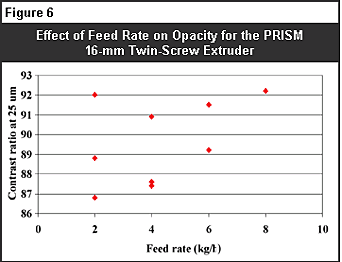
Results
Effect of feed rate on opacity-The effect of feed rate on opacity was studied on both the PRISM 16-mm twin-screw extruder and the Buss PCS30-11D single-screw extruder. For both extruders, a relationship between feed rate and opacity could not be found. In Figure 6, the poor correlation is shown for the PRISM 16-mm twin-screw extruder.
At each chosen feed rate, several powder coatings were produced using different screw speeds; hence, several opacity results are shown for each of the 2, 4, 6 and 8 kg/h feed rates.
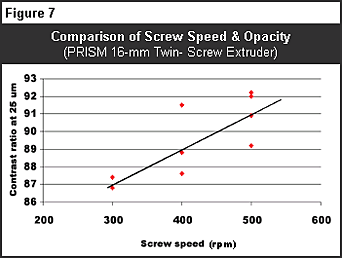
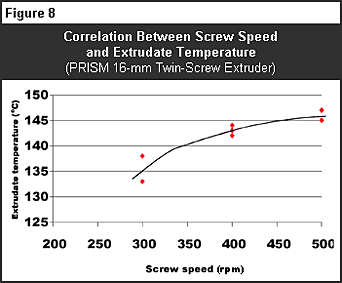
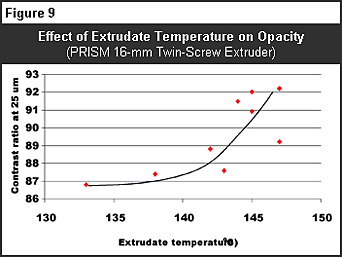
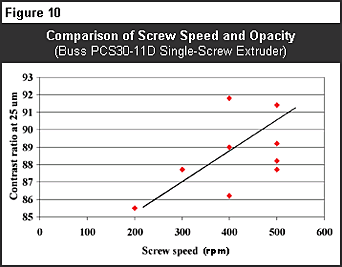
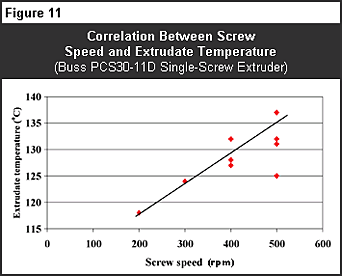
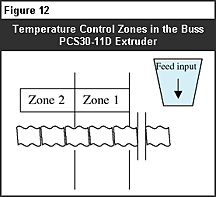
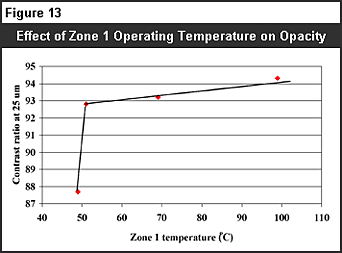
The four powder coatings have resulted in a broad range of opacities, ranging from 87.7% to 94.3%, which is obviously significant. The results suggest that by increasing the temperature in Zone 1 to 100ºC, a higher opacity can be achieved. As the effect of the Zone 2 temperature was not critical, it suggests that the temperature in the first part of the extruder is much more critical.
As a consequence of the results in Figure 13, a further series of powder coatings was produced at different extruder temperatures on the Buss PR46 single-screw extruder, currently used in the Huntsman Tioxide laboratories. The Buss PR46 extruder does not have the same level of extrusion temperature control as the Buss PCS30-11D, but it does have the ability to control the temperature of the cooling jacket around the screw. Five powder coatings were produced by increasing the cooling-jacket temperature by 10ºC intervals, from 100ºC to 140ºC. To go above 140ºC would not be advisable because crosslinking would start to occur at about 150ºC.
In Figure 14, the opacity of the five powder coatings is shown. Initially, when increasing the cooling-jacket temperature by just 10ºC, from 100ºC to 110ºC, a notable increase in opacity was noted (1st series). When increasing the temperature beyond 110ºC, an increase in opacity was still observed, but to a much lesser extent. To investigate the initial large increase in opacity, a further two series of powder coatings (2nd and 3rd series) were produced at extrusion temperatures ranging from 100ºC and 140ºC.
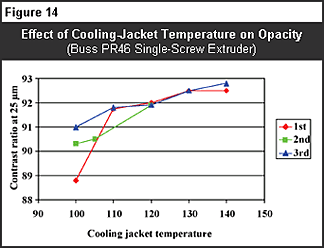
The difference in opacity between the powder coating produced at 140ºC and the opacity of an air-drying alkyd paint at the same TiO2 loading (about 94%) is not large. In fact, it's not much larger than the resin refractive index difference between the two systems.
To ensure that the reason behind this increased opacity with the increased extrusion temperature was not due to yellowing of the powder coating at the higher temperatures, the color of the powder coatings was measured.
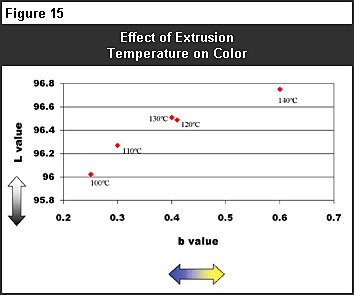
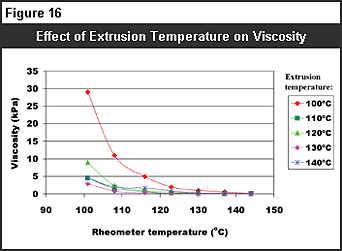
| l2 = | K t glv Cosq |
| 2h |
where, in the case of a powder coating:
1 = distance of solution penetration within the air cavities
h = viscosity of the molten powder
K = effective cavity radius
t = penetration time
glv = interfacial free energy coefficient for the molten powder-vapor transition
q = contact angle between the molten powder and the solid
The powder coating produced at the lower temperature of 100ºC has resulted in the highest viscosity, while the difference in viscosity between the four remaining powder coatings is negligible. The higher result for the powder coating produced at an extrusion temperature of 100ºC does suggest that the dispersion is poorer, which relates well to the lower opacity measured for this coating.
Discussion and conclusions
It has been shown that operating the extruder during powder coating production at as high a temperature as possible without causing crosslinking can give opacity advantages. The higher temperatures obviously result in better pigment dispersion, giving rise to the increase in opacity.Most modern extruders allow for specific temperature control in several zones along the extruder screw itself. The temperature in the first part of the extrusion zone in the single-screw extruder proved to be more critical for the final product opacity than the temperature in the latter part of the extruder.
To apply these findings to production-scale extruders could be difficult with the older type of extruders, which rely on heat transfer from the barrel only. However, with the more modern extruders, which control the temperature mainly through the screw, which is much more accurate due to its smaller surface area, this should not be problematic.
The work has also confirmed the strong correlation between screw speed and extrudate temperature. By increasing the screw speed, an increase in extrudate temperature occurred, which resulted in increased product opacity.
It is interesting to note that the most opaque films were achieved by increasing the screw speed, which also resulted in more shear going into the product and higher final extrudate temperatures, while high opacities could be achieved just by increasing the operating temperature but keeping the screw speed, and hence shear, constant. This suggests that a high extruder operating temperature is more critical to the opacity result than increased shear.
The effect of feed rate on opacity was found to be insignificant.
The above findings were found to be true for both twin- and single-screw extruders. Neither screw type gave rise to significantly more opaque powder coatings than the other, which suggests that both extruders are able to disperse the pigment equally well.
Acknowledgements
Acknowledgements are due to PRISM (UK) and Buss (Switzerland) for their cooperation with the laboratory work for this project. Acknowledgements are also due to Stephen Seymour for his support in the laboratory.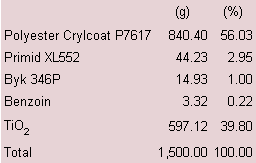
Appendix
Formulation detailsProduction details
Premixing-The raw-material components of a powder coating formulation are premixed prior to extrusion to equalize the dry aggregate sizes of each ingredient in an attempt to ensure a more efficient dispersion.All the standard formulation ingredients were premixed in a water-cooled Henschel mixer at a rotor speed of 1,800 rpm for five minutes.
Post extrusion-The chipped extrudate was ground in a Mini-Kek pin disk mill, after which the chipped extrudate was passed through a 200-mesh sieve to remove particles over 75µm, before spraying.

Report Abusive Comment